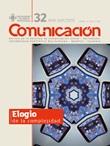Fan Shot Multi-Cam: A Complex Communication Phenomenon. Interdisciplinay Research Project
Main Article Content
Abstract
From the perspective of cultural studies, reflection proposes an interdisciplinary approach for socio-communicative readings on social uses of technology interconnected in leisure and entertainment. The term Fan Shot Multi-Cam as a specific communication phenomenon that arises from the mutated forms of use of interconnected spaces in these devices is discussed. In considering this practice as a category of analysis, it condenses on the demonstration of a point sociocultural activity is explored from the organization, capturing, editing and managing videos; but in his study, derived concepts that underpin and justify the ways in which subjects are changing the ways we relate to the current environment intercommunicated serving mainly items about how we use technological devices in our daily lives.
The project fosters theoretical and methodological crosses between the field of Communication, Sociology of Technology, Studies in the Visual Culture, Virtual Anthropology and future theoretical and mathematical achievements from the Sociocybernetics in order to strengthen the appropriate scaffolding for analyze in depth specifics of these new complex communication phenomena.
References
Ayers, M. (2006). CyberSounds: Essays on Virtual Music Culture. New York: Peter Lang.
Bloor, D. (1976). Knowledge and Social Imagery. Chicago: Chicago University Press.
Bravo, E. (2007). El Consumo musical alternativo de los jóvenes en la Ciudad de México.
Estudio de Caso: Ska, punk, dark y rock. México: UACM. (Tesis de licenciatura)
Bravo, E. (2013) La Interfaz virtual como catalizador de aprendizaje complejo. El caso Myspace.com. Argentina: FPyCS. UNLP. (Tesis Doctoral).
Buck-Morss, S. (2005). Estudios visuales e imaginación global. En estudios Fan shot Multi-Cam Visuales. La epistemología de la visualización en la era de la globalización (pp.143-157). Madrid: Akal.
Castells, M. (2013). Enredados para la libertad, Movimientos sociales en la era de Internet. (Conferencia Magistral), Universidad del Valle de Atemajac, México.
Covo, C. y Moravec, J. (2011). Aprendizaje Invisible. Hacia una Nueva Ecología de la Educación.
Barcelona: Publicacions i Edicions de la Universitat de Barcelona.
De Kerckove, D. (1999). Inteligencias en conexión. Hacia una sociedad de la web. 1ª Edición.
Barcelona: Gedisa.
Diodato, R. (2011). Estética de lo virtual. México: Universidad Iberoamericana.
Gibson, J., (1977). The theory of the affordances. New Jersey: R. Shaw & J. Bransford.
Jenkins, H., (2008). Convergence Culture: La cultura de convergencia de los medios de comunicación. Barcelona: Paidós Ibérica.
Latour, B., (1993). Nunca hemos sido modernos. Cambridge: Harvard University Press.
Lazló-Barabasi, A., (2010). Bursts: The Hidden Pattern Behind Everything We Do. USA: Duton.
Logan, R.K., (1997). The Extended Mind: Understanding Language and Thought in Terms of
Complexity and Chaos Theory. Wisconsin: Marquette University. Milwaukee.
McLuhan, H.M., (1964). Understanding media: The Extensions of Man. Cambridge Massachusetts: MIT Press.
Martel, F., (2010). Cultura mainstream. Cómo nacen los fenómenos de masas. Madrid: Taurus Pensamiento
Ong, Walter (1977). Interfaces of the Word: Studies in the Evolution of Consciousness and Culture. London: Cornell University Press.
Ong, Walter (1982) Orality and Literacy: The Technologizing of the World. New York:
Routledge. Merton, K. R. (1973). The Sociology of Science. Chicago: Chicago University Press.
Postman, Neil (1998) “Five Things We Need to Know About Technological Change”. (Essay), Denver, Colorado. U.S.A.
Regulillo, R. (2012). Navegaciones errantes. De músicas, jóvenes y redes. De Facebook a YouTube y viceversa. Revista Comunicación y Sociedad, 1, 135-171.
Scolari, C. (2004). Hacer Clic. Hacia una sociosemiótica de las interacciones digitales. España: Gedisa.
Scolari, C. (2013) Narrativas transmedia. Cuando todos los medios cuentan. España: Deusto-Planeta.

